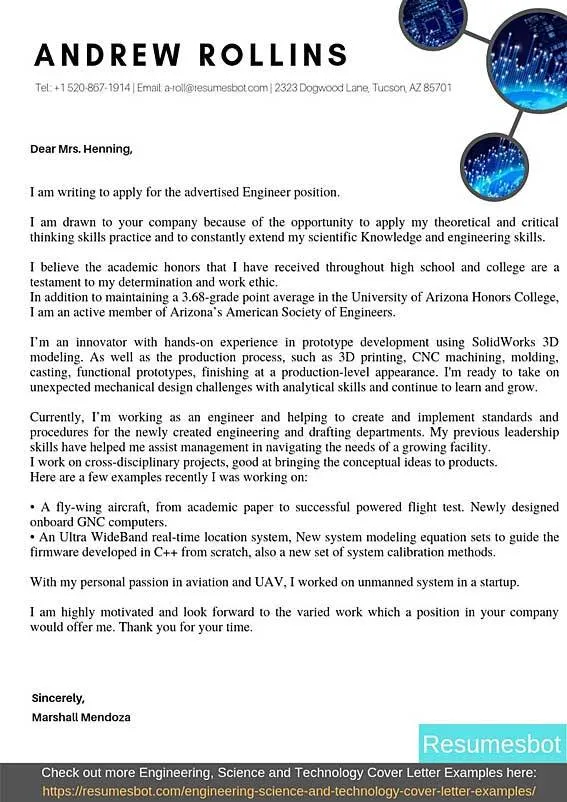What is an Engineer Cover Letter
An engineer cover letter is a crucial document that accompanies your resume when applying for engineering positions. It serves as your introduction to the hiring manager, providing a platform to elaborate on your qualifications, experiences, and suitability for the role. Unlike a resume, which presents a factual overview of your skills and history, a cover letter allows you to articulate your enthusiasm, personality, and specific reasons for applying. It’s an opportunity to connect with the employer on a more personal level and demonstrate why you’re the ideal candidate. A well-crafted cover letter can significantly increase your chances of getting an interview and ultimately landing the job. It is often the first impression, it needs to be amazing.
Why is a Cover Letter Important for Engineers
In the competitive field of engineering, a cover letter is important because it offers the chance to go beyond the basic information presented in your resume. It allows you to showcase your soft skills, such as communication, problem-solving, and teamwork, which are essential for success in engineering roles. The cover letter also enables you to demonstrate your understanding of the specific requirements of the job and how your skills align with them. This personalization shows that you’ve taken the time to research the company and the position, making you stand out from other applicants. Moreover, a cover letter lets you express your passion for engineering and your genuine interest in the company, which can leave a lasting positive impression on the hiring manager. A great cover letter can make the difference.
Key Elements of a Compelling Engineer Cover Letter
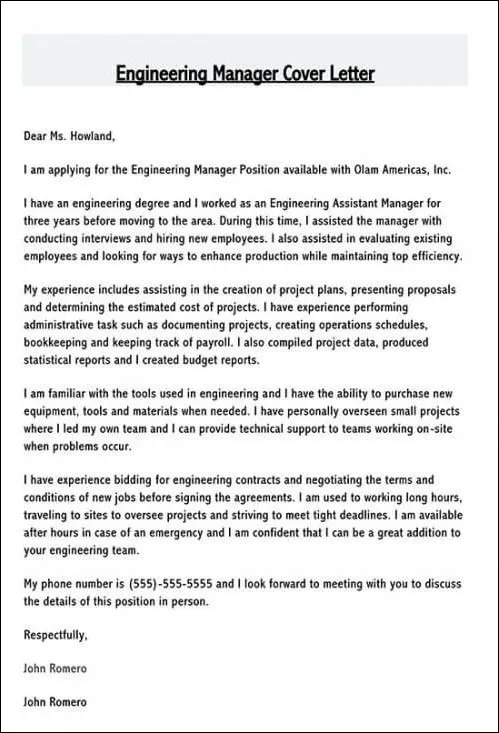
A compelling engineer cover letter should include several key elements to capture the hiring manager’s attention and highlight your qualifications effectively. Start with a professional header containing your contact information and the date. Then, address the hiring manager by name, if possible, to personalize your letter. In the opening paragraph, clearly state the position you’re applying for and how you learned about it. The body of the letter should emphasize your relevant skills and experience, providing specific examples of your achievements and contributions in previous roles. Quantify your accomplishments whenever possible to demonstrate your impact. Explain how your skills and experiences align with the job requirements and the company’s values. Finally, express your enthusiasm for the opportunity and your eagerness to learn more during an interview. Close with a professional closing and your signature.
Formatting Your Engineer Cover Letter
Proper formatting is important for an engineer cover letter. Choose a clean, easy-to-read font like Times New Roman, Arial, or Calibri, with a font size between 10 and 12 points. Use single-spacing within paragraphs and double-spacing between paragraphs to improve readability. Maintain consistent margins (typically 1 inch on all sides) to create a balanced layout. Ensure your letter is well-structured with clear headings, concise paragraphs, and bullet points to highlight key information. Keep the letter to one page, as hiring managers often have limited time to review applications. Use a professional and formal tone throughout the letter. Proofread carefully for any grammatical errors or typos. A well-formatted letter showcases your attention to detail and professionalism, which are crucial qualities for an engineer.
Header and Contact Information
The header of your engineer cover letter is the first element a hiring manager will see, so it’s important to get it right. Include your full name, address, phone number, and professional email address at the top left or right corner of the page. Use a clear and easy-to-read font. The date should be included below your contact information, typically on the left side. If you are sending an email, your contact information can be at the end of the email. Ensure that the information is accurate and up-to-date. Make sure the font size is appropriate and consistent with the rest of the document. The goal is to provide the hiring manager with all the necessary details to contact you easily. A well-designed header projects professionalism and attention to detail.
Personalized Salutation

A personalized salutation is a great way to make your engineer cover letter more engaging and show that you have done your research. Instead of using generic greetings such as “To Whom It May Concern,” try to find the name of the hiring manager or the person responsible for reviewing applications. You can often find this information on the company’s website, LinkedIn, or the job posting itself. If you cannot find a specific name, try using a title, such as “Dear Hiring Manager” or “Dear [Department] Team.” This approach demonstrates your initiative and attention to detail. Personalization can make your letter stand out from the crowd and create a more positive first impression. Ensure that you spell the name correctly and double-check the title.
Highlighting Your Skills and Experience
Highlighting your skills and experience effectively is essential for an engineer cover letter. Start by carefully reviewing the job description to identify the key skills and qualifications the employer is seeking. Then, in the body of your letter, provide specific examples of how your skills and experience align with those requirements. Use action verbs to describe your accomplishments and quantify your results whenever possible. For example, instead of saying “Managed projects,” say “Managed a team of 5 engineers, delivering projects on time and within budget.” Provide details about your relevant projects, including your role, the challenges you faced, and the solutions you implemented. Tailor your descriptions to match the specific requirements of the job, demonstrating your understanding of the role and your ability to excel in it.
Showcasing Relevant Projects and Achievements
Showcasing your relevant projects and achievements is a critical part of a successful engineer cover letter. Choose projects that are most relevant to the job you are applying for and highlight your key contributions and accomplishments within each one. When describing a project, include the project’s objective, your role, the technologies you used, and the results you achieved. Be specific and provide quantifiable data to support your claims. For example, instead of saying “Improved efficiency,” say “Improved project efficiency by 15% through the implementation of a new process.” Discuss any challenges you faced and how you overcame them. Use action verbs to describe your actions and showcase your skills. By demonstrating your ability to successfully complete projects and achieve tangible results, you can increase your chances of landing the interview.
Tailoring Your Cover Letter to the Job Description
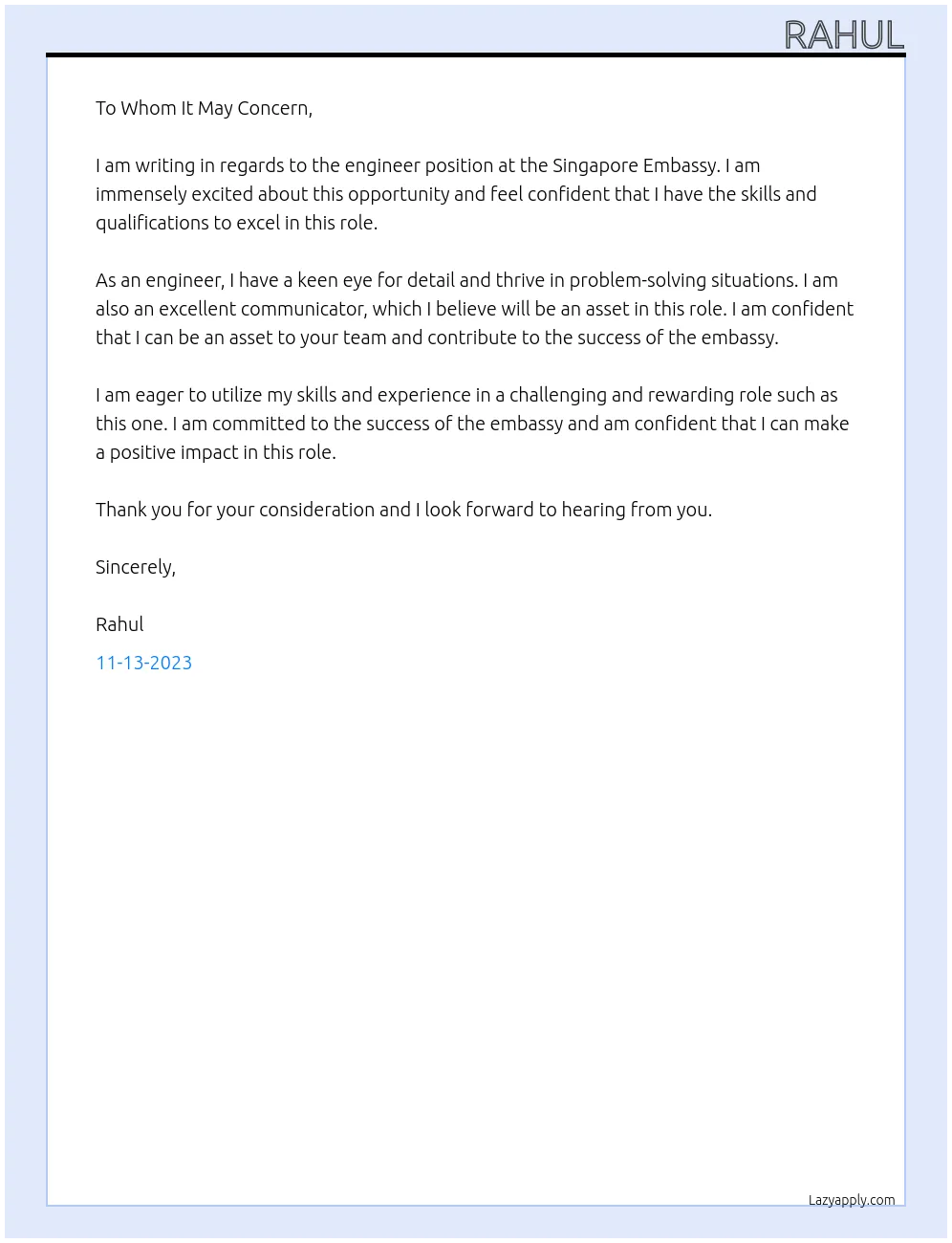
Tailoring your cover letter to the job description is a crucial step in making your application stand out. Carefully review the job posting to identify the key skills, qualifications, and responsibilities the employer is looking for. Then, customize your cover letter to address those specific requirements. Highlight your relevant skills and experiences, providing concrete examples of how you have demonstrated them in the past. Use the same keywords and phrases that are used in the job description to demonstrate that you understand the role and its requirements. Show how your skills and experiences align with the company’s values and goals. This level of personalization shows the hiring manager that you have taken the time to research the position and that you are a good fit for the role.
Using Action Verbs and Quantifiable Results
Using action verbs and quantifiable results can make your engineer cover letter much more impactful. Action verbs like “managed,” “designed,” “developed,” “implemented,” and “analyzed” make your descriptions more dynamic and engaging. They also help to showcase your accomplishments and contributions in a clear and concise manner. Quantifiable results provide concrete evidence of your impact and help to demonstrate your value. Instead of saying “Improved efficiency,” say “Improved efficiency by 15% by implementing a new process.” Include numbers, percentages, and other measurable data to support your claims. The use of action verbs and quantifiable results makes your cover letter more credible and persuasive. It can grab the reader’s attention. It demonstrates that you have achieved meaningful results in your previous roles.
Demonstrating Your Understanding of the Company
Demonstrating your understanding of the company in your engineer cover letter is important. It shows the hiring manager that you have done your research and are genuinely interested in the organization. Research the company’s mission, values, products or services, and recent achievements before you start writing. In your cover letter, mention specific aspects of the company that resonate with you and explain why you are excited about the opportunity. Tailor your cover letter to the company’s culture and values. If possible, address a specific project, product, or initiative that the company is involved in and explain how your skills and experience align with it. Showing that you understand the company’s goals and challenges will make you a more attractive candidate.
Expressing Your Enthusiasm and Interest
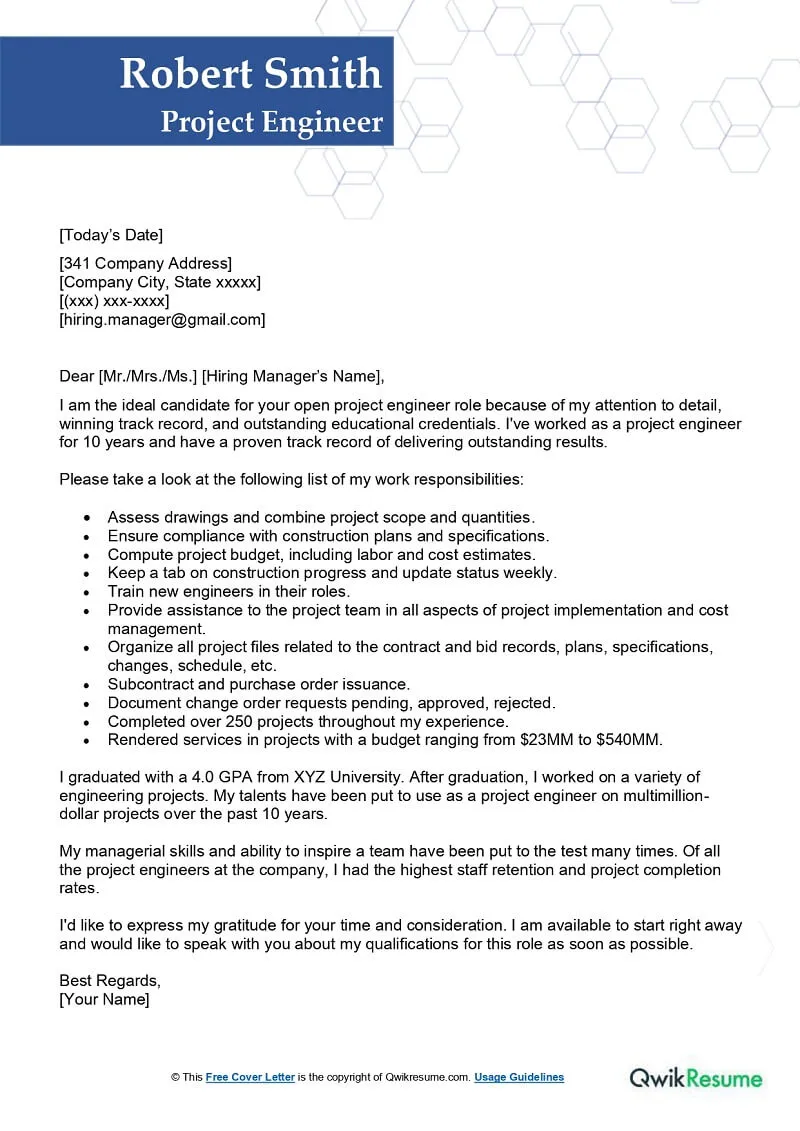
Expressing your enthusiasm and interest is a key part of a great engineer cover letter. Let your personality shine through and convey your genuine passion for engineering and the specific role you are applying for. Use strong and positive language to describe your interest in the company and the opportunity. Explain why you are excited about the role and what you hope to achieve if you are hired. Be specific about what aspects of the role or company interest you. Make sure your enthusiasm is genuine and reflects your authentic interest in the company. This can make a lasting positive impression on the hiring manager. Your eagerness will make you more memorable and increase your chances of getting an interview.
Proofreading and Editing Your Cover Letter
Proofreading and editing your engineer cover letter is an essential step. Even a small mistake can undermine your professionalism and credibility. Before submitting your cover letter, carefully read it multiple times, looking for any errors in grammar, spelling, punctuation, and sentence structure. Consider using a grammar and spell-checking tool, but always review the suggestions carefully. Ask a friend, family member, or career counselor to read your letter and provide feedback. They may catch errors or suggest improvements that you missed. Ensure that the formatting is consistent and professional. Proofreading shows your attention to detail and commitment to excellence. Take the time to review and refine your cover letter to create the best possible impression.
Common Mistakes to Avoid in an Engineer Cover Letter
Avoid some common mistakes that can hurt your chances of landing an engineering job. Don’t send a generic cover letter that could be used for any job. Tailor your letter to each specific position. Avoid typos and grammatical errors. Proofread carefully before submitting your application. Don’t be overly long or rambling. Keep your letter concise and focused. Don’t repeat the information from your resume. Instead, use the cover letter to elaborate on your qualifications and highlight your achievements. Avoid using jargon or technical terms that the hiring manager may not understand. Keep the language clear and accessible. Don’t be negative or critical of previous employers or colleagues. Present yourself in a positive and professional light. Ensure your letter is well-formatted. Following these tips will increase the chance of getting an interview.
Tips for Following Up After Submitting Your Cover Letter
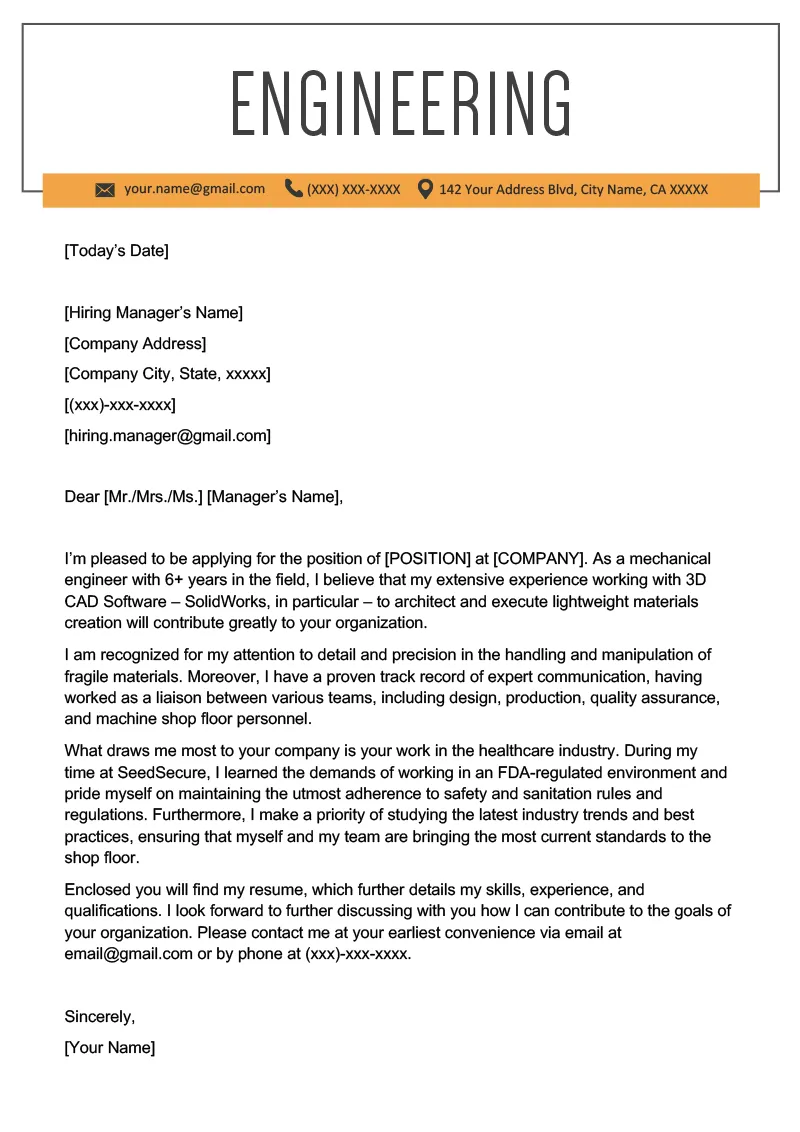
Following up after submitting your engineer cover letter can demonstrate your interest in the position and increase your chances of getting an interview. Send a polite follow-up email or make a phone call to the hiring manager a week or two after submitting your application. In your follow-up, reiterate your interest in the role and thank the hiring manager for their time. Briefly mention your key qualifications and how they align with the job requirements. Be respectful of the hiring manager’s time and avoid being pushy or demanding. Use the opportunity to ask if they have any questions or need any additional information. If you don’t hear back after your initial follow-up, you can send a second email a week or two later. Following up can leave a positive impression and show the hiring manager you are proactive.
